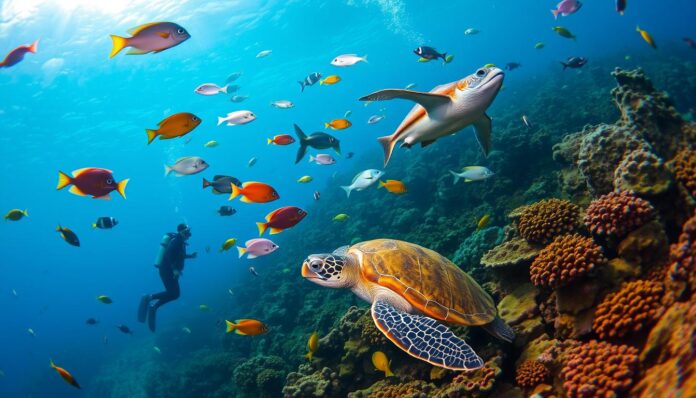| Best Time to Travel | August-December |
| What to Expect | Varied marine life, including sharks, turtles, and rays; coral reefs; shipwrecks |
| Diving Conditions | Warm water (75-82°F), visibility of up to 100 feet |
| Marine Life | Whale sharks, hammerhead sharks, turtles, rays, moray eels, lionfish, parrotfish, angelfish, and many more |
Have you ever wondered what secrets lie beneath Costa Rica’s crystal-clear waters? Imagine diving into a world where vibrant marine life dances around you. Underwater landscapes tell stories millions of years in the making.
Scuba Diving in Costa Rica offers an unparalleled adventure. It transforms ocean exploration into an extraordinary journey. Costa Rica, nestled between the Pacific Ocean and the Caribbean Sea, has dive sites that promise unforgettable experiences for both novice and experienced divers.
From the legendary Cocos Island to the breathtaking Cano Island, these waters host an incredible marine ecosystem. Divers can encounter hammerhead sharks, manta rays, and an array of tropical fish. Costa Rican waters are a true underwater paradise.
Key Takeaways – Scuba Diving in Costa Rica
- Costa Rica offers diverse diving experiences across Pacific and Caribbean coasts
- Multiple dive sites with unique marine life and underwater landscapes
- Water temperatures range from 22° to 29°C (72° to 84°F)
- Peak diving seasons vary by location
- Home to world-renowned dive spots like Cocos Island
- Suitable for divers of all skill levels
- Rich biodiversity with opportunities to see rare marine species
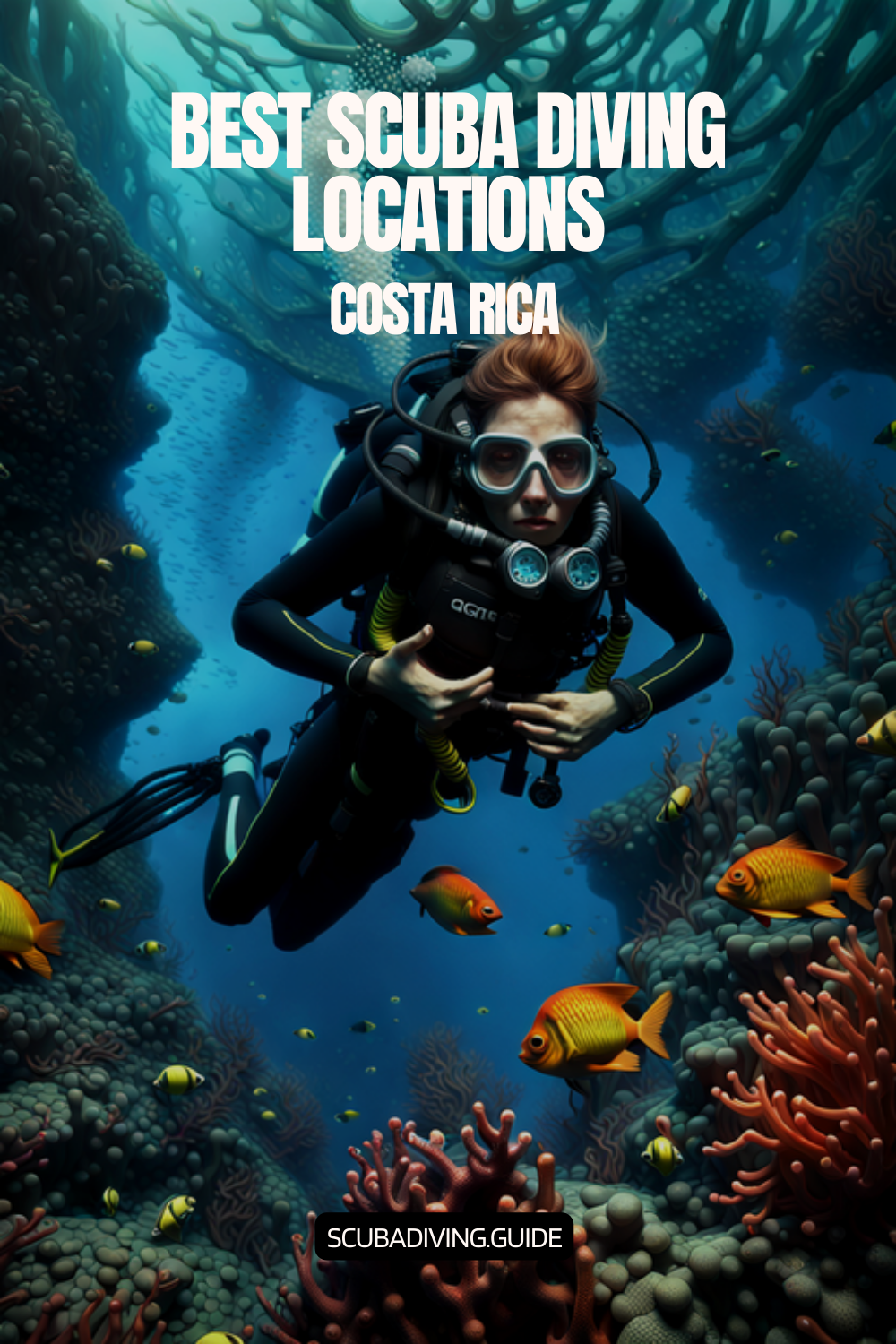
Introduction to Scuba Diving in Costa Rica
Costa Rica is a top spot for underwater adventures. It’s filled with colorful marine life and diverse ecosystems. Its unique location makes it a dream for scuba lovers everywhere.
Diving in Costa Rica is a mix of stunning beauty and amazing sea creatures. The tropical waters around this Central American country are perfect for underwater explorations.
Why Costa Rica is a Diver’s Paradise
Costa Rica is great for diving because of several reasons:
- Nutrient-rich Pacific Ocean currents
- Diverse marine ecosystems
- Warm water temperatures
- Exceptional visibility
Unique Marine Biodiversity
The underwater world of Costa Rica is full of life. Divers can see many marine species in different areas.
| Diving Region | Water Temperature | Visibility Range | Notable Marine Life |
|---|---|---|---|
| Pacific Coast | 26-30°C | 10-30 meters | Tropical fish, Sharks |
| Caribbean Coast | 24-28°C | 15-25 meters | Coral reefs, Tropical fish |
“Diving in Costa Rica is not just an activity, it’s an exploration of a living, breathing underwater world.”
The Pacific side is best for underwater exploration in Costa Rica. It has great conditions for all divers. From easy dives to deep sea adventures, there’s something for everyone.
Best Time for Scuba Diving
Planning your Costa Rica Diving Adventures means knowing the best times to dive. The tropical climate offers different diving experiences all year. Each season brings its own unique marine wonders.
Seasonal Weather Considerations
Costa Rica’s diving season has two main periods, each with its own underwater magic:
- Rainy Season (May to November):
- Peak diving conditions from mid-May to late November
- Lower accommodation prices
- More peaceful diving environments
- Dry Season (December to April):
- Clear waters with minimal river run-off
- Optimal visibility for underwater exploration
- Higher tourist traffic
Water Temperature Ranges
Knowing the water temperatures is key for diving in Costa Rica. The marine environment stays warm, with slight changes:
| Location | Dry Season Temp | Rainy Season Temp |
|---|---|---|
| Pacific Coast | 26-29°C (78-85°F) | 26-30°C (78-86°F) |
| Caribbean Coast | 26-29°C (78-85°F) | 26-30°C (78-86°F) |
| Cocos Island | 21°C (70°F) | 26-27°C (78-82°F) |
“The beauty of diving in Costa Rica is that you can explore incredible marine ecosystems year-round!” – Local Diving Expert
Pro Tip: Water temperatures stay pretty steady, but expect short rains in the rainy season. These rains last about an hour or two. They don’t ruin the dive and can even make it better.
Top Diving Locations in Costa Rica
Costa Rica’s dive sites are a top choice for scuba diving fans worldwide. The Pacific Coast is home to a wide range of marine environments. From colorful coral reefs to stunning underwater landscapes, diving in Costa Rica is an adventure you won’t forget.
Costa Rica has many amazing diving spots, each with its own special marine life. These places offer unique underwater experiences and incredible marine encounters.
Cocos Island: A Diving Mecca
Cocos Island is a UNESCO World Heritage Centre and a top diving spot. This remote island is perfect for advanced divers looking for shark encounters. Here, divers can see:
- Massive schools of hammerhead sharks
- Incredible biodiversity
- Pristine marine ecosystems
Cano Island: Marine Life Encounters
Cano Island Biological Reserve is known for its clear waters and diverse marine life. It’s a key marine sanctuary with beautiful underwater landscapes.
The Bat Islands: Bull Shark Diving
The Bat Islands, off northwest Costa Rica, offer exciting dives. Divers can look forward to:
- Encounters with bull sharks
- Approximately 50-minute boat rides from the mainland
- Challenging diving conditions
| Dive Location | Key Features | Difficulty Level |
|---|---|---|
| Cocos Island | Shark encounters | Advanced |
| Cano Island | Marine sanctuary | Intermediate |
| Bat Islands | Bull shark interactions | Advanced |
“Costa Rica’s dive sites are not just locations, they’re underwater universes waiting to be discovered.” – Marine Expedition Journal
Scuba diving in Costa Rica is a chance to explore some of the world’s most diverse marine environments. Each dive site has its own charm and marine ecosystem.
Safety Tips for Scuba Diving
Scuba Diving in Costa Rica needs careful planning and safety focus. Every dive requires detailed planning and knowledge of safety rules. This ensures a fun and safe dive.
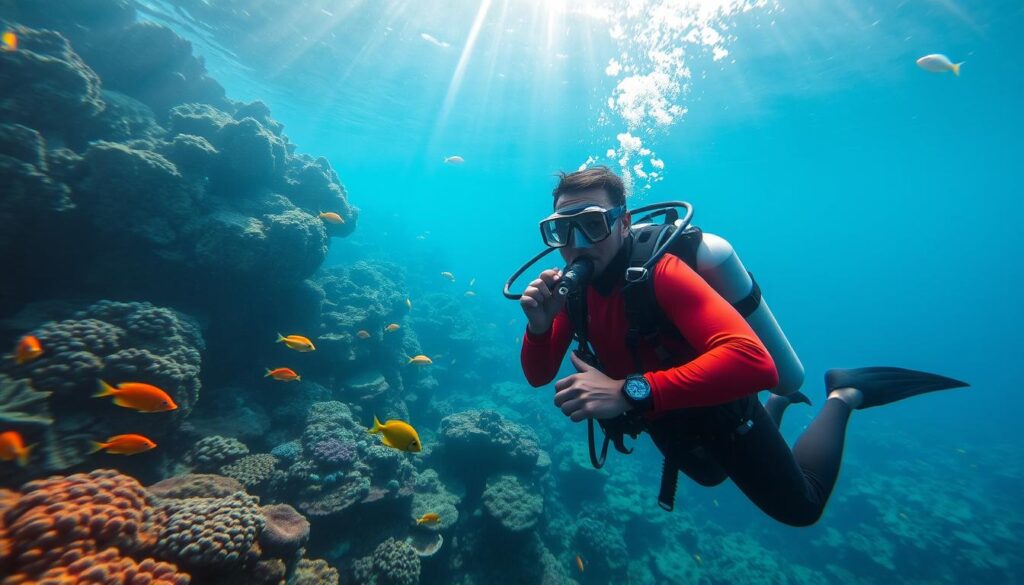
Experienced divers know safety begins before diving. It’s important to check your gear and know local rules for a great dive.
Essential Equipment Checks
Before diving in Costa Rica, do a full gear check:
- Look for cracks or seal damage in your mask
- Make sure your regulator works right
- Check that your buoyancy compensator (BC) inflates properly
- Test your air tank’s pressure and valve connections
- Make sure all straps and buckles are tight
“A well-maintained gear is your first line of defense underwater” – Professional Diving Instructor
Understanding Local Diving Regulations
Costa Rican dive spots have rules to protect divers and marine life. Some important rules include:
- You must fill out a medical questionnaire before diving
- There are limits on the number of tourists at marine reserves
- You need to dive with a licensed local guide
- You must follow strict conservation rules
Emergency Preparedness
Always carry important safety gear for diving in Costa Rica:
- Surface marker buoy for visibility
- GPS emergency device
- Updated emergency contact info
- Dive operator emergency contact details
Preparation turns risks into unforgettable underwater adventures in Costa Rica.
Scuba Diving Courses and Certifications
Costa Rica is a top spot for divers looking to improve their skills. Its varied marine life makes it perfect for both new and seasoned divers to learn more.
Diving Certification Costa Rica offers many chances for divers to grow. There are courses for all levels, from beginners to advanced.
Introductory Courses for Beginners
New divers can begin with PADI’s Open Water Diver certification. It’s a well-known program that introduces you to scuba diving.
- Minimum age requirement: 14 years old
- Course duration: 2-3 days
- Includes 5 confined water dives and 4 open water dives
- Maximum depth for beginners: 60 feet
Advanced Diving Training
Costa Rica has advanced programs for those who want to dive deeper. These courses push your skills to the next level.
| Certification Level | Duration | Key Features |
|---|---|---|
| Advanced Open Water | 2-3 days | 5 specialized dives, including Deep and Navigation |
| Rescue Diver | 3-4 days | Emergency response training, real-life scenario simulations |
Diving Certification Costa Rica has flexible programs in English and Spanish. This makes it easy for people from all over to join. The PADI 5 Star Dive Center ensures top-notch training.
“Learning to dive in Costa Rica isn’t just about certification—it’s about discovering a whole new world beneath the waves.”
Costa Rica is great for both new and experienced divers. Its diving certification programs will make your underwater adventure unforgettable.
Marine Life You Can Encounter
Exploring the underwater world in Costa Rica is a treat for divers. The marine life here is vibrant and diverse. It offers an unforgettable experience with many fascinating creatures to discover.
Divers get to see a colorful world filled with marine life. Each dive is a unique adventure. The underwater world is full of species that make every dive special.
Colorful Coral Reefs and Marine Inhabitants
Costa Rica’s marine ecosystems are home to amazing marine life. This includes:
- 10 different species of spiny lobster in shallow waters
- 16 species of moray eels
- Several octopus species under 2 feet in size
- Nudibranchs ranging from match tip to lettuce leaf sizes
Fascinating Fish and Large Marine Species
Exploring Costa Rica’s underwater world reveals incredible marine creatures. These include:
| Marine Species | Characteristics |
|---|---|
| Blue and Gold Snapper | Up to 12 inches, found within 50 feet depth |
| Big Eye Jacks | Schools measuring 2.5 to 3 feet long |
| Whale Sharks | 25 to 35 feet in length, commonly sighted near surface |
“The ocean’s diversity in Costa Rica is a testament to the incredible marine ecosystem waiting to be explored.” – Marine Biology Research Team
Underwater enthusiasts can also expect remarkable ray and whale encounters. These include:
- Cownose rays in schools of 200 to 10,000
- Giant Pacific Manta Rays spanning 14 to 24 feet
- Spotted eagle rays typically found in groups of 15 to 20
- Humpback whales migrating through Pacific waters
Every dive in Costa Rica is an unforgettable journey. It takes you through a living, breathing underwater world full of wonders.
Sustainable Diving Practices
Costa Rica is a world leader in protecting the environment. It’s a top spot for scuba divers who care about the planet. With about 5% of the world’s biodiversity, it’s a chance to see marine life while diving responsibly.
Diving in Costa Rica is more than just seeing the beauty below. It’s about helping to protect the marine world that makes this place so special.
Eco-Friendly Diving Guidelines
Responsible divers can make a big difference. Here are some key steps:
- Use reef-safe sunscreens to prevent chemical damage to coral ecosystems
- Master buoyancy control to avoid accidental damage to underwater structures
- Never touch or disturb marine life
- Remove any trash encountered during dives
- Use eco-friendly diving gear
Supporting Conservation Efforts
Costa Rica has many ways for divers to help protect the sea:
| Conservation Activity | Impact |
|---|---|
| Beach Clean-up Events | Reduce plastic pollution in marine environments |
| Coral Reef Restoration Programs | Help rebuild damaged marine ecosystems |
| Marine Life Monitoring | Support scientific research and conservation |
“Every dive is an opportunity to protect and preserve the underwater world we love.”
By diving sustainably in Costa Rica, you’re not just seeing amazing marine life. You’re also helping to protect one of the planet’s most valuable natural places.
Dive Shops and Operators in Costa Rica
Scuba diving in Costa Rica is amazing, thanks to many dive shops and operators. They serve both new and seasoned divers. The country’s sea life is diverse, making it perfect for underwater adventures.
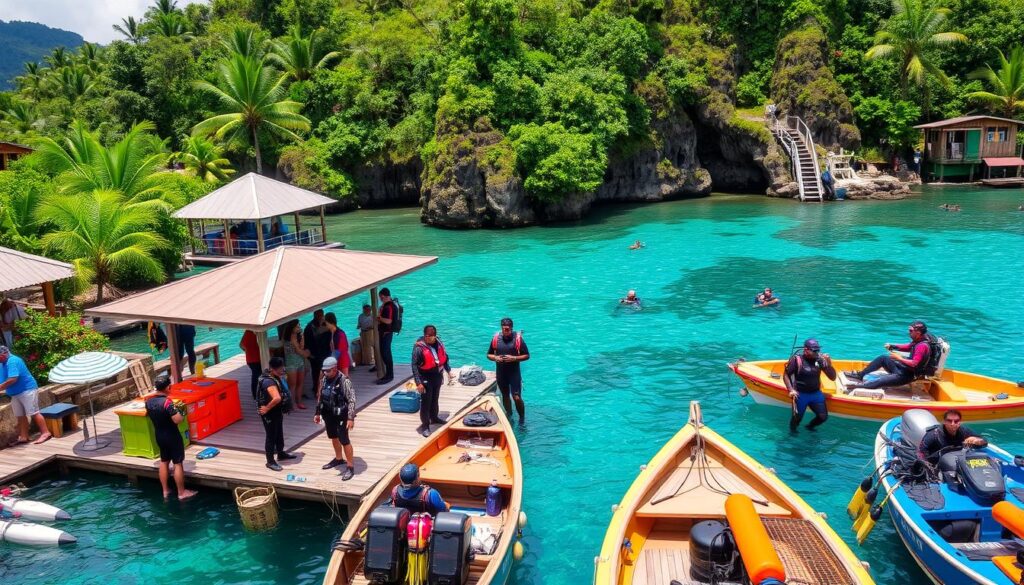
Choosing a dive operator in Costa Rica is easy with so many great options:
Top Dive Shops to Consider
- Oceans Unlimited – A PADI 5* IDC center in Playas del Coco with 25 years of diving experience
- Deep Blue Diving – The only PADI 5* Resort in Playas del Coco, known for Gulf of Papagayo trips
- Costa Rica Divers – Focuses on diving courses at Isla del Caño and Bahia Ballena National Park
- Summer-Salt Dive Center – Located in Guanacaste, perfect for certified divers
Guided Dive Tours and Packages
Costa Rica Dive Resorts have great packages. They include:
- PADI certification courses from Open Water to Advanced levels
- Day trips to top diving spots like Caño Island
- Small group diving experiences
- Eco-friendly tours that help marine conservation
“Diving in Costa Rica isn’t just an activity, it’s an immersive journey into marine biodiversity” – Local Diving Expert
Popular dive sites in the Pacific are easy to reach by day-trip boats. Towns like Tamarindo, Jaco, and Puntarenas offer these trips. You’ll get top-notch boats, skilled guides, and unforgettable dives that highlight Costa Rica’s marine life.
Scuba Diving Gear Essentials
Getting ready for diving in Costa Rica means planning and the right gear. The right equipment is key for a safe and fun dive. It ensures you enjoy Scuba Diving in Costa Rica.
What to Bring for Your Dive Trip
Choosing the right diving gear is vital for a great dive. Here’s a list of must-haves:
- Mask: Cressi SF1 Scuba Mask ($80) offers clear vision
- Fins: Clio snorkel fins ($45) provide excellent underwater mobility
- Wetsuit: Cressi Lido Long Wetsuit ($130) for thermal protection
- Safety Device: Nautilus Lifeline Marine Rescue GPS ($295)
- Dive Computer: Cressi Leonardo Dive Computer ($345)
“Always invest in quality gear that fits well and keeps you comfortable underwater.”
Rental vs. Personal Gear
When planning your dive in Costa Rica, you’ll decide between renting or using your own gear. Personal gear has many benefits:
- Familiarity with your own equipment
- Custom fit and comfort
- Better maintenance and reliability
- Reduced risk of equipment malfunction
Rentals are convenient, but experts say own gear is best. Light and compact gear is perfect for travel. It prepares you for Costa Rica’s varied marine life.
PADI dive centers in Costa Rica offer advice on choosing the right gear. They help you pick the best for your dive.
Family-Friendly Diving Options
Costa Rica Diving Adventures offers exciting opportunities for families to explore the underwater world together. Not every family member may be a certified scuba diver. But, that doesn’t mean they can’t enjoy the underwater adventures Costa Rica has to offer.
Families looking to dive into marine experiences have many options. These options help create unforgettable memories. The region provides unique ways for both adults and children to engage with the stunning marine environment.
Scuba Experiences for Kids
Children can start their diving journey surprisingly early. PADI Jr. open water certification can be earned around age 10. Advanced certification typically achievable by age 13. Kids Sea Camp offers specialized programs to introduce young divers to the underwater world:
- PADI SASY (Supplied Air Snorkeling for Youth) program
- PADI Seal Team introductory courses
- Supervised diving experiences
Snorkeling Alternatives
For younger children or less experienced family members, snorkeling is an excellent alternative. The waters around Tortuga are welcoming for novice underwater explorers.
| Age Group | Recommended Activity | Location |
|---|---|---|
| 8-10 years | Snorkeling | Tortuga Waters |
| 10-13 years | Junior Diving Courses | Guanacaste Region |
| 13+ years | Certified Diving | Catalina Islands |
Pro tip: Water temperatures in Guanacaste range from 80.4°F to 85.3°F. This makes it comfortable for all family members to enjoy marine activities throughout the year.
“Diving is a family adventure that creates lifelong memories” – Diving Experts
Families can explore multiple options. From shallow snorkeling spots to guided junior diving experiences. This ensures everyone can participate in the marine excitement Costa Rica provides.
Health and Safety Before Diving
Getting ready for diving in Costa Rica means focusing on health and safety. Scuba diving here needs careful planning for a safe and fun dive. Knowing about medical issues and taking the right steps can greatly improve your diving experience.
Medical Considerations for Diving
Before diving in Costa Rica, getting a medical check is key. Divers need to think about several health points:
- Complete a thorough medical check-up
- Share any health problems you have
- Get a doctor’s okay for diving
- Watch out for health issues like heart or breathing problems
“Safety underwater starts long before you dive” – Professional Diving Association
Hydration and Sun Protection Strategies
Diving in the tropics has its own challenges. Staying hydrated and protecting yourself from the sun are vital to avoid health problems.
| Hydration Tips | Sun Protection Measures |
|---|---|
| Drink 2-3 liters of water every day | Use reef-safe sunscreen SPF 50+ |
| Avoid drinking alcohol before diving | Wear clothes that protect you from the sun |
| Drink drinks with lots of electrolytes | Wear a hat with a wide brim |
Critical Safety Statistics: – Drowning is one of the top causes of death for U.S. travelers abroad – 75% of water recreation deaths involve alcohol – Wait 12-24 hours after diving before flying
By sticking to these tips, divers can lower risks and enjoy more of Costa Rica’s stunning underwater world.
Planning Your Dive Trip
Getting ready for diving in Costa Rica needs careful planning. The country has amazing underwater sights in many places. It’s a favorite spot for scuba lovers of all levels.
Picking the best spot is key for a great dive. Costa Rica Dive Resorts are in the best spots. They give you access to incredible marine worlds.
Best Locations for Divers
Costa Rica has many top diving spots:
- Cocos Island: Famous for hammerhead shark sightings
- Caño Island: Home to a wide variety of marine life
- Bat Islands: Great for advanced divers who want to see sharks
- Catalina Islands: Perfect for seeing whale sharks and manta rays
Accommodations Near Diving Spots
Choosing the right place to stay is important. Coastal towns have many options for different tastes and budgets:
| Location | Proximity to Dive Sites | Recommended For |
|---|---|---|
| Tamarindo | Close to Pacific dive sites | Intermediate divers |
| Playa Potrero | Easy access to offshore locations | Experienced divers |
| Jaco | Multiple dive center options | Beginners and advanced divers |
| Puntarenas | Gateway to Cocos Island | Advanced expedition divers |
Pro tip: Stay near dive centers to save time and dive more.
“Costa Rica offers an unparalleled diving experience that combines breathtaking marine life with stunning tropical landscapes.” – Marine Exploration Magazine
When planning your dive trip in Costa Rica, remember these important points:
- Make sure you have the right dive certification
- Check when the best marine life is out
- See if you can rent equipment
- Know what’s included in your dive package
With good planning, your dive trip in Costa Rica will be unforgettable. You’ll explore amazing marine worlds.
Costa Rica Recommended Scuba Diving Itinerary
Costa Rica offers a wealth of scuba diving opportunities that can be tailored to suit various preferences and interests. To make the most of your scuba diving adventure in Costa Rica, consider the following recommended itinerary that showcases the country’s diverse marine ecosystems and captivating underwater landscapes.
Day 1: Arrival and Acclimation
Upon arrival in Costa Rica, settle into your accommodations and take some time to acclimate to the local environment. If you’re staying in a dive resort or near a diving center, familiarize yourself with the facilities and meet with the staff to discuss your diving plans.
Day 2-3: Guanacaste Province
Start your diving journey by exploring the breathtaking dive sites in the Guanacaste province. This region is known for its proximity to marine national parks and offers opportunities to encounter vibrant coral reefs, schools of tropical fish, and larger pelagic species such as whitetip reef sharks and giant manta rays. Spend a couple of days diving in this area, exploring different sites and getting comfortable in the water.
Day 4-5: Central Pacific Coast
Head towards the central Pacific coast, where you’ll find renowned diving destinations such as Manuel Antonio and the Gulf of Papagayo. Dive among underwater pinnacles, volcanic rock formations, and encounter an array of marine life including colorful reef fish, turtles, and occasional nurse sharks. Take the time to explore both the diverse marine environments and the beautiful coastal scenery.
Day 6-7: Southern Pacific Coast
Venture to the southern region of Costa Rica, where you’ll discover extraordinary diving opportunities in places like Caño Island and Drake Bay. Dive in crystal-clear waters, explore submerged volcanic formations, and encounter an abundance of marine life including reef sharks, rays, dolphins, and even humpback whales during the migratory season. Take advantage of the biodiversity-rich waters and indulge in multiple dives to fully immerse yourself in this remarkable underwater realm.
Day 8-9: Cocos Island Liveaboard
Embark on an unforgettable liveaboard journey to Cocos Island, located far off the Pacific coast of Costa Rica. Join a multi-day liveaboard trip that takes you to this UNESCO World Heritage site, known for its thrilling drift dives and encounters with large pelagic species. Dive alongside hammerhead sharks, whale sharks, manta rays, and other mesmerizing marine creatures that call these waters home. The remote location and exceptional diving conditions make this a truly extraordinary experience.
Day 10: Relaxation and Reflection
As your scuba diving adventure in Costa Rica comes to an end, take the opportunity to relax and reflect on your incredible experiences. Spend the day enjoying the amenities of your accommodation, strolling along the beach, or exploring the local culture and cuisine. Take time to appreciate the beauty of Costa Rica’s coastal landscapes and cherish the memories you’ve created during your scuba diving journey.
This recommended scuba diving itinerary in Costa Rica provides a well-rounded exploration of the country’s diverse diving opportunities. However, it’s important to note that the itinerary can be customized based on your personal preferences, time constraints, and diving experience level. Work closely with local dive centers, resorts, or liveaboard operators to design a tailored itinerary that meets your specific interests and allows you to make the most of your time underwater.
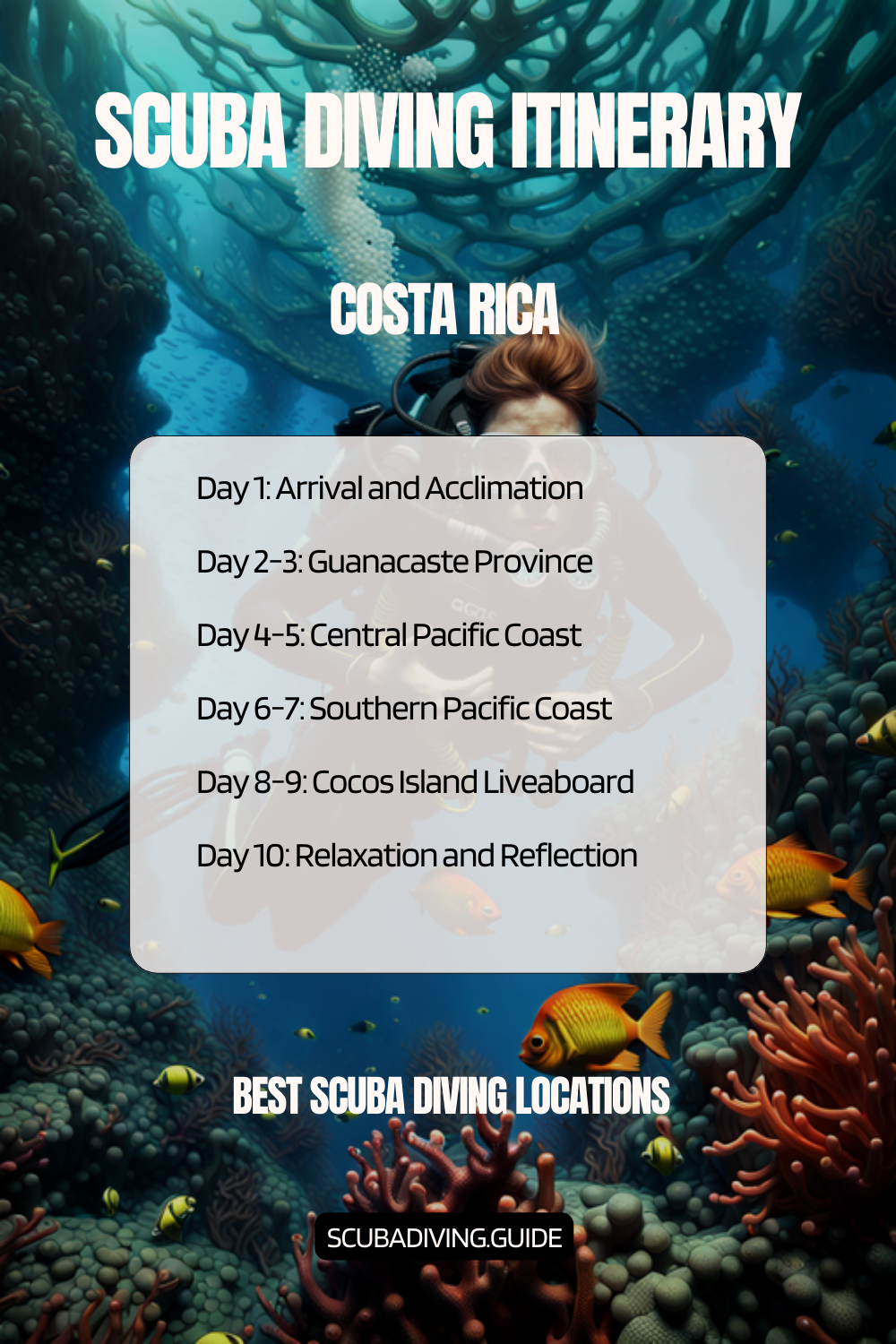
Other Countries to Consider
Conclusion: Experience Diving Adventure in Costa Rica
Scuba Diving in Costa Rica is an amazing journey under the sea. It mixes stunning marine life with eco-friendly exploration. You can dive at places like Isla del Caño and the Catalina Islands. Or visit the famous Cocos Island National Park for unforgettable moments.
Costa Rica has diving adventures for everyone. Beginners can dive in calm waters from December to April. Experienced divers can see huge marine animals like humpback whales in the rainy months. Dive operators like Rich Coast Diving and Deep Blue Diving make sure your dives are safe and fun.
It’s important to dive responsibly in Costa Rica. Using reef-safe sunscreens and joining reef clean-ups helps protect the sea. By following local laws, divers help keep these amazing places safe. Costa Rica’s warm waters and rich marine life make it a top spot for diving.
The underwater world of Costa Rica is waiting for you. Dive in and make memories that will last forever. You’ll also help protect one of the world’s most incredible marine ecosystems.
FAQ – Scuba Diving in Costa Rica
What makes Costa Rica a unique destination for scuba diving?
Costa Rica is special for scuba diving because of its location. It’s between the Pacific Ocean and the Caribbean Sea. The waters are rich in nutrients, home to many marine creatures like sharks and colorful fish.
Its underwater world is diverse, with volcanic rocks and coral reefs. This makes it a paradise for those who love to explore underwater.
When is the best time to go scuba diving in Costa Rica?
The best time to dive varies by location. On the Pacific coast, the dry season from December to April has clear waters. The Caribbean side is great from March to October.
Each season offers different marine life experiences. So, the best time depends on what you want to see.
What are the top diving locations in Costa Rica?
Costa Rica has three famous diving spots. Cocos Island is known for sharks. Cano Island is rich in marine life. The Bat Islands are thrilling for bull shark encounters.
Each place offers a unique diving experience. You can see everything from big pelagic species to colorful tropical fish.
Do I need a specific certification to dive in Costa Rica?
Most dive sites require at least an Open Water certification. Beginners can get introductory courses in Costa Rica. Experienced divers can get advanced certifications.
For challenging sites like Cocos Island, you might need more experience and certifications.
What marine life can I expect to see while diving in Costa Rica?
You can see many marine creatures, like white-tip reef sharks and manta rays. Sea turtles and tropical fish are common too.
Depending on the location and season, you might see whale sharks and dolphins. Costa Rica’s underwater world is truly amazing.
Are there eco-friendly diving options in Costa Rica?
Yes! Costa Rica is a leader in sustainable tourism. Many dive operators focus on eco-friendly practices.
There are dive trips and marine research programs that support conservation. You can help protect the marine environment while diving.
What should I bring for a diving trip to Costa Rica?
Bring your certification card, dive log, and personal dive computer. Don’t forget swimwear, reef-safe sunscreen, and your preferred diving gear.
Many dive shops rent out equipment. But bringing your own ensures comfort. Check with your dive operator about what you need.
Is scuba diving in Costa Rica suitable for families?
Yes, Costa Rica is great for family diving and snorkeling. Many dive centers offer programs for kids, including introductory courses.
Snorkeling is a good option for younger family members. It lets everyone enjoy the marine environments without needing a diving certification.
What health considerations should I keep in mind before diving?
Get a medical check-up before diving to make sure you’re fit. Stay hydrated in the tropical climate and protect yourself from the sun.
Be aware of health risks like decompression sickness. Most dive operators will ask for a medical questionnaire and may want a recent clearance for diving.
How can I choose a reputable dive operator in Costa Rica?
Look for dive shops with good safety records and positive reviews. Make sure they are certified by organizations like PADI or SSI.
Check their safety protocols, equipment, and group sizes. Recommendations from diving forums and local tourism boards can help you choose.
